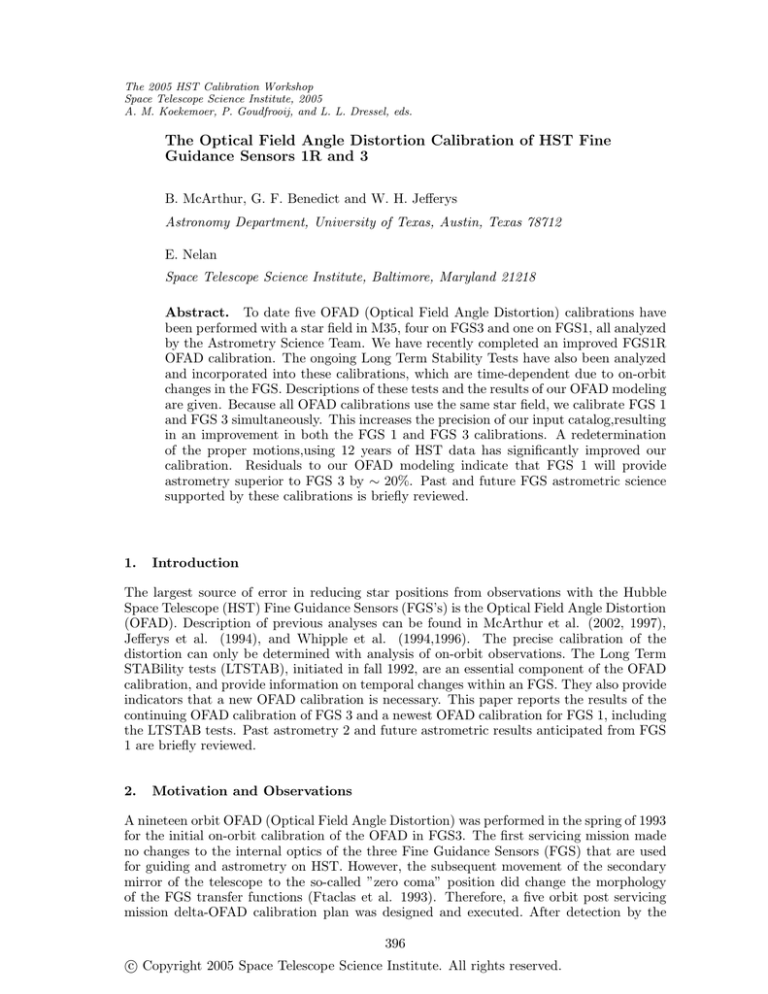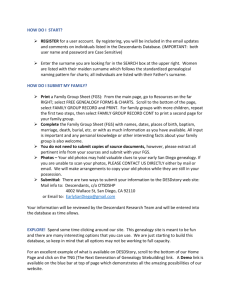
The 2005 HST Calibration Workshop
Space Telescope Science Institute, 2005
A. M. Koekemoer, P. Goudfrooij, and L. L. Dressel, eds.
The Optical Field Angle Distortion Calibration of HST Fine
Guidance Sensors 1R and 3
B. McArthur, G. F. Benedict and W. H. Jefferys
Astronomy Department, University of Texas, Austin, Texas 78712
E. Nelan
Space Telescope Science Institute, Baltimore, Maryland 21218
Abstract. To date five OFAD (Optical Field Angle Distortion) calibrations have
been performed with a star field in M35, four on FGS3 and one on FGS1, all analyzed
by the Astrometry Science Team. We have recently completed an improved FGS1R
OFAD calibration. The ongoing Long Term Stability Tests have also been analyzed
and incorporated into these calibrations, which are time-dependent due to on-orbit
changes in the FGS. Descriptions of these tests and the results of our OFAD modeling
are given. Because all OFAD calibrations use the same star field, we calibrate FGS 1
and FGS 3 simultaneously. This increases the precision of our input catalog,resulting
in an improvement in both the FGS 1 and FGS 3 calibrations. A redetermination
of the proper motions,using 12 years of HST data has significantly improved our
calibration. Residuals to our OFAD modeling indicate that FGS 1 will provide
astrometry superior to FGS 3 by ∼ 20%. Past and future FGS astrometric science
supported by these calibrations is briefly reviewed.
1.
Introduction
The largest source of error in reducing star positions from observations with the Hubble
Space Telescope (HST) Fine Guidance Sensors (FGS’s) is the Optical Field Angle Distortion
(OFAD). Description of previous analyses can be found in McArthur et al. (2002, 1997),
Jefferys et al. (1994), and Whipple et al. (1994,1996). The precise calibration of the
distortion can only be determined with analysis of on-orbit observations. The Long Term
STABility tests (LTSTAB), initiated in fall 1992, are an essential component of the OFAD
calibration, and provide information on temporal changes within an FGS. They also provide
indicators that a new OFAD calibration is necessary. This paper reports the results of the
continuing OFAD calibration of FGS 3 and a newest OFAD calibration for FGS 1, including
the LTSTAB tests. Past astrometry 2 and future astrometric results anticipated from FGS
1 are briefly reviewed.
2.
Motivation and Observations
A nineteen orbit OFAD (Optical Field Angle Distortion) was performed in the spring of 1993
for the initial on-orbit calibration of the OFAD in FGS3. The first servicing mission made
no changes to the internal optics of the three Fine Guidance Sensors (FGS) that are used
for guiding and astrometry on HST. However, the subsequent movement of the secondary
mirror of the telescope to the so-called ”zero coma” position did change the morphology
of the FGS transfer functions (Ftaclas et al. 1993). Therefore, a five orbit post servicing
mission delta-OFAD calibration plan was designed and executed. After detection by the
396
c Copyright 2005 Space Telescope Science Institute. All rights reserved.
The Optical Field Angle Distortion Calibration of HST FGS 1R and 3
397
LTSTAB of increasing incompatibility with the spring 1994 delta-OFAD calibration, an 11
orbit OFAD was performed in the fall of 1995 to recover the error budget for astrometry,
after In the spring of 1997 a five orbit OFAD was performed on FGS3 after the second
servicing mission. In December of 2000,a 14 orbit OFAD was performed on FGS1R, which
replaced FGS3 as the prime astrometer for scientific observations. FGS1R, an enhanced
FGS with an adjustable fold-flat mirror that can be commanded from the ground, had
replaced the original FGS1 instrument in February of 1997 in SM2(Servicing Mission 2).
Seventy LTSTABS (Long Term Stability Tests) have been performed in both FGS1R and
FGS3 to assess time-dependent changes. A current list of the OFAD and LTSTAB tests is
shown in Table 1.
3.
Optical Field Angle Distortion Calibration and Long Term Stability Test
The Optical Telescope Assembly (OTA) of the HST (Hubble Space Telescope) is a Aplanatic
Cassegrain telescope of Ritchey-Chrètien design. The aberration of the OTA, along with
the optics of the FGS comprise the OFAD. The largest component of the design distortion,
which consists of several arcseconds, is an effect that mimics a change in plate scale. The
magnitude of non-linear, low frequency distortions is on the order of 0.5 seconds of arc
over the FGS field of view. The OFAD is the most significant source of systematic error
in position mode astrometry done with the FGS. We have adopted a pre-launch functional
form originally developed by Perkin-Elmer (Dente, 1984). It can be described (and modeled
to the level of one millisecond of arc) by the two dimensional fifth order polynomial:
x0 = a00 + a10 x + a01 y + a20 x2 + a02 y 2 + a11 xy + a30 x(x2 + y 2 ) + a21 x(x2 − y 2 )
+a12 y(y 2 − x2 ) + a03 y(y 2 + x2 ) + a50 x(x2 + y 2 )2 + a41 y(y 2 + x2 )2
+a32 x(x4 − y 4 ) + a23 y(y 4 − x4 ) + a14 x(x2 − y 2 )2 + a05 y(y 2 − x2 )2
y 0 = b00 + b10 x + b01 y + b20 x2 + b02 y 2 + b11 xy + b30 x(x2 + y 2 ) + b21 x(x2 − y 2 )
+b12 y((y 2 − x2 ) + b03 y(y 2 + x2 ) + b50 x(x2 + y 2 )2 + b41 y(y 2 + x2 )2
+b32 x((x4 − y 4 ) + b23 y(y 4 − x4 ) + b14 x(x2 − y 2 )2 + b05 y(y 2 − x2 )2
(1)
where x, y are the observed position within the FGS field of view, x’, y’ are the corrected
position, and the numerical values of the coefficients aij and bij are determined by calibration. Although ray-traces were used for the initial estimation of the OFAD, gravity release,
outgassing of the graphite-epoxy structures, and post-launch adjustment of the HST secondary mirror required that the final determination of the OFAD coefficients aij and bij be
made by an on-orbit calibration.
M35 was chosen as the calibration field. Since the ground-based positions of our target
calibration stars were known only to 23 milliseconds of arc, the positions of the stars were
estimated simultaneously with the distortion parameters. This was accomplished during
a nineteen orbit calibration, executed on 10 January 1993 in FGS number 3. GaussFit (
Jefferys, 1988), a least squares and robust estimation package, was used to simultaneously
estimate the relative star positions, the pointing and roll of the telescope during each orbit
(by quaternions), the magnification of the telescope, the OFAD polynomial coefficients,
and these parameters that describe the star selector optics inside the FGS: ρA and ρB (the
arm lengths of the star selectors A and B), and κA and κB (the offset angles of the star
selectors). Because of the linear relationship between ρA , ρA , κA and κB , the value of κB
is constrained to be zero. A complete description of that calibration, the analysis of the
data, and the results are given in Jefferys et al. (1994).
398
McArthur et al.
Table 1: LTSTAB and OFAD Observations.
Orbit
1
2
3-21
22
23
24
25
26
27
28
29
30
31
32
33-37
38
39
40
41
42
43
44
45
46
47
48
49
50-60
61
62
63
64
65
66
67
68
69
70
71
72-76
77
78
79
80
81
82
83
84
85
86
87
88
89
90
91
92
93
94
95
96
97
98
99
100
101-114
115
116
117
118
119
120
121
122
123
124
125
126
127
128
129
130
131
132
133
134
135
136
137
138
139
140
141
142
Julian Date
2448959.340822
2448971.061435
2448997.782164
2449082.954086
2449095.742836
2449096.613044
2449226.341817
2449255.529236
2449283.771053
2449309.341898
2449379.838241
2449408.794850
2449437.560417
2449468.662153
2449469.602118
2449593.554884
2449624.182975
2449652.274942
2449683.371435
2449711.665382
2449749.996910
2449780.160903
2449811.662894
2449838.070301
2449990.553542
2450018.625255
2450042.360197
2450052.674838
2450112.122350
2450133.837824
2450158.835440
2450174.716192
2450199.778704
2450321.550822
2450353.777465
2450377.443275
2450416.366701
2450480.031933
2450518.768090
2450560.517523
2450717.416169
2450743.225891
2450783.224190
2450822.077315
2450847.955266
2450904.886979
2450924.644942
2451054.361725
2451113.296366
2451121.224560
2451153.943299
2451163.019213
2451184.786771
2451189.556088
2451300.596829
2451300.664236
2451416.507917
2451430.269572
2451555.127963
2451555.199688
2451649.638229
2451653.660590
2451783.159410
2451830.321088
2451899.105289
2451968.923102
2452021.654896
2452137.970671
2452201.355764
2452263.961701
2452274.313264
2452295.219942
2452370.867882
2452384.694618
2452520.528970
2452581.074271
2452631.260370
2452700.778437
2452749.608044
2452883.589838
2452953.9450698
2452997.011609
2453002.8817249
2453066.547211
2453118.7410301
2453234.513866
2453359.537685
2453363.535428
2453431.767731
2453480.676921
2453599.337049
2453639.847894
2453680.156250
Year
1992
1992
1993
1993
1993
1993
1993
1993
1993
1993
1994
1994
1994
1994
1994
1994
1994
1994
1994
1994
1995
1995
1995
1995
1995
1995
1995
1995
1996
1996
1996
1996
1996
1996
1996
1996
1996
1997
1997
1997
1997
1997
1997
1998
1998
1998
1998
1998
1998
1998
1998
1998
1999
1999
1999
1999
1999
1999
2000
2000
2000
2000
2000
2000
2000
2001
2001
2001
2001
2001
2001
2002
2002
2002
2002
2002
2002
2003
2003
2003
2003
2003
2003
2004
2004
2004
2004
2004
2005
2005
2005
2005
2005
Day
337
349
10
95
108
109
238
268
296
321
27
56
85
116
117
241
271
299
330
359
32
62
94
120
273
301
324
335
29
51
76
92
117
239
271
294
333
31
70
112
268
294
334
8
34
91
111
240
299
307
340
349
6
11
122
121.2
238
251
11
11
106
110
239
286
355
59
112
228
291
354
364
20
96
110
246
306
356
0610
110
244
314
357
363
62
114
234
355
359
61
110
228
269
309
FGS
3
3
3
3
3
3
3
3
3
3
3
3
3
3
3
3
3
3
3
3
3
3
3
3
3
3
3
3
3
3
3
3
3
3
3
3
3
3
3
3
3
3
3
3
3
1
3
3
3
1
3
1
1
3
3
1
3
1
1
3
1
3
1
1
1
1
1
1
1
1
1
3
1
1
1
1
1
1
1
1
1
1
1
1
1
1
1
1
1
1
1
1
1
Observation
LTSTAB
LTSTAB
OFAD
LTSTAB
LTSTAB
LTSTAB
LTSTAB
LTSTAB
LTSTAB
LTSTAB
LTSTAB
LTSTAB
LTSTAB
LTSTAB
Spring Delta-OFAD
LTSTAB
LTSTAB
LTSTAB
LTSTAB
LTSTAB
LTSTAB
LTSTAB
LTSTAB
LTSTAB
LTSTAB
LTSTAB
LTSTAB
Fall Delta-OFAD
LTSTAB
LTSTAB
LTSTAB
LTSTAB
LTSTAB
LTSTAB
LTSTAB
LTSTAB
LTSTAB
LTSTAB
LTSTAB
Spring Delta-OFAD
LTSTAB
LTSTAB
LTSTAB
LTSTAB
LTSTAB
LTSTAB
LTSTAB
LTSTAB
LTSTAB
LTSTAB
LTSTAB
LTSTAB
LTSTAB
LTSTAB
LTSTAB
LTSTAB
LTSTAB
LTSTAB
LTSTAB
LTSTAB
LTSTAB
LTSTAB
LTSTAB
LTSTAB
OFAD
LTSTAB
LTSTAB
LTSTAB
LTSTAB
LTSTAB
LTSTAB
LTSTAB
LTSTAB
LTSTAB
LTSTAB
LTSTAB
LTSTAB
LTSTAB
LTSTAB
LTSTAB
LTSTAB
LTSTAB
LTSTAB
LTSTAB
LTSTAB
LTSTAB
LTSTAB
LTSTAB
LTSTAB
LTSTAB
LTSTAB
LTSTAB
LTSTAB
Coefficient Set
1
1
1
1
1
1
1
1
1
1
2
2
2
2
2
2
2
2
2
2
2
2
2
2
3
3
3
3
3
3
3
3
3
3
3
3
3
3
3
3
3
3
3
3
3
4
3
3
3
4
3
4
4
3
3
4
3
4
4
3
4
3
4
4
4
4
4
4
4
4
4
3
4
4
4
4
4
4
4
4
4
4
4
4
4
4
4
4
4
4
4
4
4
The Optical Field Angle Distortion Calibration of HST FGS 1R and 3
399
In late fall 1992, just prior to the 1993 OFAD calibration, a series of one orbit long-term
stability tests (LTSTAB) was initiated. These tests had two seasonal orientations, a spring
orientation taken from an orbit of the OFAD, and a fall orientation, which was a 180 degree
flip of the spring orientation. LTSTABs have been performed several times in each of the
orientations, spring and fall, every year.
The LTSTAB is sensitive to scale and low order distortion changes. It is an indicator of
the validity of the current OFAD coefficients and the need for recalibration. The LTSTAB
series immediately showed that the scale measured by the FGS was changing with time. The
indication of this change was seen in the large increase with time in the post-fit residuals
from a solution that solved for a constant sets of star positions, star selector encoder (SSE)
parameters, and OFAD parameters. The amount of scale change is too large to be due to
true magnification changes in the HST optical telescope assembly. These changes could be
due to water desorption in the graphite-epoxy components within the FGS. Initially the
scale -like change was modeled by allowing a variation in the star-selector-A effective lever
arm(ρA ). Since 1995, the change has been modeled by allowing a change in both ρA and
κA (the offset angle of the star selector).
A five orbit delta-OFAD was performed on 27 April 1994 after the first servicing mission
to assess the distortion changes caused by the secondary mirror movement to the zero coma
position. Significant effects in the OFAD (in addition to the scale-like changes) at the level
of 10 mas were found. The LTSTAB tests have revealed continued permutations in the FGS.
In addition to the scale changes, in mid-1995 we began to recognize higher order distortion
changes. These changes manifested themselves as something that looks like a radial scale
variation and is fairly well modeled by alterations in the third order terms in Eq. (1). We
had also noted that the residuals from the fall orientation LTSTABS are consistently higher
than for the spring in FGS3.
An eleven orbit delta-OFAD was performed in the late fall of 1995, to analyze temporal
changes, and upgrade the y-axis coverage. The star catalog was redetermined with input
from the three OFAD experiments of 1993, 1994 and 1995 to minimize the OFAD distortion
that could have been absorbed by the catalog positions. A more complete analyses of this
delta-OFAD can be found in McArthur 1997.
In the spring of 1997 a second servicing mission replaced FGS1. A five orbit delta-OFAD
was performed in FGS3, repeating the orientation of spring 1994. The coefficients produced
by this 5 orbit delta-OFAD did not provide a better calibration than the 11 orbit Fall of 1995
delta-OFAD calibration, so these orbits were used instead as LTSTABS. Two LTSTABS
were performed in Spring 1997, one before and one after the second servicing mission. With
scale and offset removed, a comparison yielded an rms of 0.965 mas, indicating stability of
FGS3 across the servicing mission.
At the end of 2000, a 14 orbit OFAD was executed in FGS1R, for a total of approximately observations. Figure 1 shows the rotations and offsets of FGS1R in this OFAD
calibration. In the first FGS1R OFAD, we entered the McNamara (1986) proper motion
values as observations with error in a quasi-Bayesian fashion, instead of being applied as
constants. More recently, we carefully examined the HST derived proper motions on their
own, in cases where there were significant numbers of observations over significant time
spans. These HST derived motions, are used in a weighted solution with the McNamara
proper motions for the stars not so frequently observed. For this calibration, we ran a model
which performed a simultaneous solution of OFAD polynomials, star selector encoder (sse)
parameters, proper motions, drift parameters, and catalog positions. This model had over
15,000 equations of conditions using all 142 OFAD and LTSTAB plates. Only the OFAD
plates determined the OFAD polynomials and complete sse parameters, while the LTSTAB
combined with the OFAD plates contributed to a time-varying rhoA and kA, proper motions, and catalog positions. Each plate formed its own drift and rotation parameters. A
systematic signature in the X residuals from the four OFAD analysis remains. This signature differs between FGS3 and FGS1. It appears as a very distinctive curve in the x
400
McArthur et al.
Figure 1: Rotation and Offsets of FGS1R Winter 2000 OFAD
6
FGS3 1993
FGS3 1994
FGS3 1995
FGS1 2000
5
4
correction in arcseconds
3
2
1
0
-1
-2
-3
-4
-5
-3
-6x10
500
400
300
200
100
0
-100
X position in arcseconds
-200
-300
-400
-500
Figure 2: Four frequency Fourier series correction of systematic signature in X Residuals
component residuals as a function of position angle in the FGS field of view (Figure 2).
The curve cannot be modeled by the fifth order polynomial. We have used a four frequency
Fourier series to remove this effect. The size of this effect, in an RMS sense over the entire
field of view of the FGS, is about one millisecond of arc. However, the peak-to-peak values
near the center of the field of view can be as large as 7 mas in FGS3. The FGS1 systematic
is much smaller with a peak to peak of about 2.5 mas. The source of this unexpected distortion is not yet known but it may be due to the way the FGS responds to the spherically
aberrated HST beam.
On the basis of almost ten years of monitoring the distortions in FGS 3 we have
concluded that at the level of a few milliseconds of arc, the optical field angle distortion in
HST FGS 3 changes with time. These changes can be monitored and modeled by continuing
the LTSTAB tests, which also alerts us to the need for a new OFAD calibration. There
remains some dichotomy between the OFAD calibration data taken in the spring and that
taken in the fall.
Five sets of OFAD coefficients (Eq. 1) and star selector parameters (M , ρA , ρB ,κA
and κB ) have been derived for reductions of astrometry observations. The average plate
residuals for these determinations are listed in Table 2. Comparisons of grids created with
each set of FGS3 OFAD coefficients and distortion parameters indicate that the OFAD has
changed around 10 milliseconds of arc in non-scalar distortion between calibrations (which
have spanned 12-18 months)in FGS3.
Each LTSTAB is associated with a specific set of coefficients Table 1. In the boundary
area betweeen two OFAD experiments, the observations are reduced with both sets of OFAD
separately to determine which coeffecients produce the best ρA κA fit of the LTSTAB.
The values of ρA and κA determined by the LTSTABS and OFADS in FGSs 1 and 2
are illustrated in Figure 3,5, 4and 6. The error bars for these determination are smaller
than the symbols. For reduction of science astrometry data, the ρA κA parameters are
determined by interpolation of the two nearest LTSTABS in time.
The most recent analysis of the OFAD, which includes the HST determined proper
motions, presents a significantly improved distortion calibration as seen in Table 2, listed
as the New Winter 2000. The residual profile of the fgs1R stars is shown in Figure 7. The
LTSTABS which have been performed since the implementation of two-gyro mode have
been consistent with previous LTSTABS and we do not expect any deterioration in this
mode of the calibration of the FGS.
The Optical Field Angle Distortion Calibration of HST FGS 1R and 3
401
-0.60
-0.61
κ A in FGS3
-0.62
-0.63
-0.64
-0.65
-0.66
-0.67
-0.68
2.4490
2.4495
2.4500
2.4505
Julian Date
2.4510
2.4515
2.4520x106
Figure 3: κA fit of the LTSTABS in FGS3
6.9090
ρ A in FGS3
6.9080
6.9070
6.9060
6.9050
6.9040
6.9030
2.4490
2.4495
2.4500
2.4505
Julian Date
2.4510
2.4515
2.4520x10
6
Figure 4: ρA fit of the LTSTABS in FGS3
Table 2: OFAD σ in millseconds of arc
OFAD
Winter 2000
Winter 2000
New Winter 2000
New Winter 2000
FGS
3
1
3
1
σX
2.3
1.6
1.5
1.3
σY
2.2
1.7
1.8
1.3
In addition to the OFAD calibration, both Lateral Color and Cross Filter calibrations
have been determined. Each FGS contains refractive elements. The position measured for
a target star (relative to a differently colored set of reference stars) could depend on its
intrinsic color, hence the lateral color corrections are applied. The large dynamic range in
magnitudes (3 ? V ? 17) requires a neutral-density filter. There is a small shift in position
(due to filter wedge) when comparing the positions of a bright star to a faint reference
frame. This shift is determined in the Cross Filter calibration.
4.
Past and Ongoing Astrometric Science with HST FGS
FGS 3 has been used to determine the first astrometrically determined mass of an extrasolar
planet, which is around the star GL 876 (ApJ letters, in press). It has been used to obtain
many trignometric parallaxes. Targets included distance scale calibrators (δCep - Benedict
et al., 2002b; RR Lyr - Benedict et al., 2002a), interacting binaries (Feige 24 - Benedict et
al., 2000), and cataclysmic variables (RW Tri - McArthur et al., 1999; TV Col- McArthur
et al., 2001; SS Cyg, U Gem & SS Aur, Harrison et. al, 1999). It was also involved in an
intensive effort to obtain masses and mass ratios for a number of very low-mass M stars
(for example, GJ 22, GJ 791.2, GJ 623, and GJ 748- Benedict et al., 2001). The average
parallax precision resulting from FGS 3 was σπ = 0.26 mas.
FGS 1 has been used to determine the parallaxes of several cataclysmic variables (EX
Hya, EF Eri, V1223 Sgr)(Beuermann et al., 2003, 2004; Harrison et al., 2004), parallaxes of
a representative set of AM CVn stars, an independent parallax of the Pleiades (Soderblom
et al., 2005), a parallax of the central star of NGC 6853 (Benedict et al., 2003) and the
masses of extrasolar planets around 55 Cancri (McArthur et al., 2004) and Eridani. The
masses of the extrasolar planets around υ Andromeda and additional planets are now being
studied. A distance determination to the Cepheids is being calculated at present from HST
402
McArthur et al.
Figure 5: κA fit of the LTSTABS in FGS1
Figure 6: ρA fit of the LTSTABS in FGS1
parallaxes. FGS 1 is also involved in an ongoing effort to obtain masses and mass ratios for
additional set of low-mass M stars.
A continued program of LTSTAB monitoring and OFAD updates is essential to the
success of these long-term investigations with FGS 1.
5.
Conclusions
We have shown that continued OFAD calibration of the Fine Guidance Sensors can reduce
this source of systematic error in positions measured by the FGS’s to the level of less than 2
mas. However, changes in the FGS units continue to occur, even twelve years after launch.
These changes require periodic updates to the OFAD to maintain this critical calibration.
Acknowledgments. The Astrometry Science Team is supported by NASA NAG51603. We are grateful to Q. Wang for the initial modeling of the OFAD and D. Story
and A.L. Whipple for their earlier contributions to this calibration. We thank L. Reed for
her long-term contribution to our knowledge of FGS3. We thank Gary Welter and Keith
Kalinowski for their interest and assistance at Goddard Space Flight Center. We thank all
the members of the STAT, past and present for their support and useful discussions.
References
Benedict, G.F., Nelan, E., McArthur, B., Story, D., van Altena, W., Ting-Gao, Y., Hemenway, P.D., Shelus, P.J., Whipple, A.L., Franz, O.G., Fredrick, L.W., and R.L. Duncombe. 1993, PASP105, 487- 493
The Optical Field Angle Distortion Calibration of HST FGS 1R and 3
403
Figure 7: Residual Histrogram from OFAD calibration of FGS1R
Benedict, G. F., McArthur, B., Chappell, D. W., Nelan, E., Jefferys, W. H., van Altena,
W., Lee, J., Cornell, D., Shelus, P. J., Hemenway, P. D., Franz, O. G., Wasserman,
L. H., Duncombe, R. L., Story, D., Whipple, A., & Fredrick, L. W. 1999, AJ, 118,
1086
Benedict, G. F., McArthur, B. E., Franz, O. G., Wasserman, L. H., Nelan, E., Lee, J.,
Fredrick, L. W., Jefferys, W. H., van Altena, W., Robinson, E. L., Spiesman, W.
J., Shelus, P. J., Hemenway, P. D., Duncombe, R. L., Story, D., Whipple, A. L., &
Bradley, A. 2000, AJ, 119, 2382
Benedict, G. F., McArthur, B. E., Franz, O. G., Wasserman, L. H., Henry, T. J., Takato, T.,
Strateva, I. V., Crawford, J. L., Ianna, P. A., McCarthy, D. W., Nelan, E., Jefferys,
W. H., van Altena, W., Shelus, P. J., Hemenway, P. D., Duncombe, R. L., Story, D.,
Whipple, A. L., Bradley, A. J., Fredrick, L. W. 2001, AJ, 121, 1607
Benedict, G. Fritz, McArthur, B. E., Fredr ick, L. W., Harrison, T. E., Lee, J., Slesnick, C.
L., Rhee, J., Patterson, R. J ., Nelan, E., Jefferys, W. H., van Altena, W., Shelus,
P. J., Franz, O. G., Wass erman, L. H., Hemenway, P. D., Duncombe, R. L., Story,
D., Whipple, A. L., & Br adley, A. J. 2002A, AJ123, 473
Benedict, G. F., McArthur, B. E., Fredrick, L. W., Harrison, T. E., Slesnick, C. L., Rhee,
J., Patterson, R. J., Skrutskie, M. F., Franz, O. G., & Wasserman, L. H. 2002B,
AJ124, 1695
Benedict, G. F., McArthur, B. E., Fredrick, L. W., Harrison, T. E., Skrutskie, M. F.,
Slesnick, C. L., Rhee, J., Patterson, R. J., Nelan, E., Jefferys, W. H., van Altena,
W., Montemayor, T., Shelus, P. J., Franz, O. G., Wasserman, L. H., Hemenway,
P. D., Duncombe, R. L., Story, D., Whipple, A. L., & Bradley, A. J. 2003, AJ, 126,
2549
Beuermann, K., Harrison, T. E., McArthur, B. E., Benedict, G. F., & Gänsicke, B. T. 2004,
A&A, 419, 291
Beuermann, K., Harrison, T. E., McArthur, B. E., Benedict, G. F., & Gänsicke, B. T. 2003,
A&A, 412, 821
Bradley, A., Abramowicz-Reed, L., Story, D., Benedict, G., and W. Jefferys. 1991, PASP,
103, 317
Dente, G. and Abramowitz-Reed, L. Space Telescope Optical Field Angle Distortion Calibration Algorithm. 1984, Perkin-Elmer ST-SE-3336.
404
McArthur et al.
Ftaclas, C., Nonnenmacher, A., Weindling, F., Story, D., and E. Nelan. 1993, Ap. Opt.
32, 1696
Harrison, T. E., McNamara, B., Szkody, P., McArthur, B. E., Benedict, G. F.,Klemola, A.,
& Gilliland, R. L. 1999, ApJ, 515, L93
Harrison, T. E., Johnson, J. J., McArthur, B. E., Benedict, G. F., Szkody, P., Howell, S. B.,
& Gelino, D. M. 2004, AJ, 127, 460
Jefferys, W., Fitzpatrick, J., and McArthur, B. 1988 Celest. Mech. 41, 39.
Jefferys, W.J., Whipple, A., Wang, Q., McArthur, B., Benedict, G.F., Nelan, E., Story, D,
and L. Abramowicz-Reed. 1994, in Calibrating Hubble Space Telescope, J.C. Blades
and S.J. Osmer (Baltimore: STScI) 353-374.
McArthur, B. E., Benedict, G. F., Jefferys, W. H., and Nelan, E. 1997, in The 1997 HST
Calibration Workshop : Hubble after the Installation of the ACS and the NICMOS
Cooling System, Santiago Arribas, Anton Koekemoer, and Brad Whitmore (Baltimore: STScI) 373.
McArthur, B. E., Benedict, G. F., Jefferys, W. H., and Nelan, E. 2003, in Proc. 2002 HST
Calibration Workshop, ed. S. Arribas, A. Koekemoer, & B. Whitmore (Baltimore:
STScI), p. 472.
McArthur, B. E., Benedict, G. F., Lee, J., Lu, C. -L., van Altena, W. F., Deliyannis, C. P.,
Girard, T., Fredrick, L. W., Nelan, E., Duncombe, R. L., Hemenway, P. D., Jefferys,
W. H., Shelus, P. J., Franz, O. G. & Wasserman, L. H. 1999, ApJ, 520, L59
McArthur, B. E. Benedict, G. F., Lee, J., van Altena, W. F., Slesnick, C. L., Rhee, J.,
Patterson, R. J., Fredrick, L. W., Harrison, T. E., Spiesman, W. J., Nelan, E.,
Duncombe, R. L., Hemenway, P. D., Jefferys, W. H., Shelus, P. J., Franz, O. G.,
Wasserman, L. H., 2001, ApJ, 560, 907
McArthur, B. E., Endl, M., Cochran, W. D., Benedict, G. F., Fischer, D. A.;,Marcy, G.
W., Butler, R. P., Naef, D., Mayor, M., Queloz, D.,Udry, S., Harrison, T. E., 2004
ApJ614, L81
McNamara, B., & Sekiguchi, K., 1986. AJ91, 557
Soderblom, D.R.,Nelan, E., Benedict, G. F., McArthur, B., Ramirez, I., Spiesman, W.,
Jones, Burton F., 2005, AJ129, 1616S
van Altena, W. F., Lu, C. -L., Lee, J. T., Girard, T. M., Guo, X., Deliyannis, C., Platais, I.,
Kozhurina-Platais, V., McArthur, B., Benedict, G. F., Duncombe, R. L., Hemenway,
P. D., Jefferys, W. H., King, J. R., Nelan, E., Shelus, P. S., Story, D., Whipple, A.,
Franz, O. G., Wasserman, L., Fredrick, L. W., Hanson, R. B., Klemola, A. R., Jones,
B. F., Mendez, R., Tsay, W. -S., Bradley, A. 1997. ApJ Lett, 486, 123
Wang, Q., and Jefferys, W. 1990, in Satatistical Analysis of the Optical Field Angle Distortion of the Hubble Space Telescope Using the Bootstrap Method, Austin:Univesrity
of Texas, Department of Astronomy Institute, 1-99.
Whipple, A., Jefferys, W., Wang, Q., McArthur, B., Benedict, G.F., Nelan, E., Story, D.,
and L. Abramowicz-Reed. 1994, in Calibrating Hubble Space Telescope, J C. Blades
and S.J. Osmer ed(s)., (Baltimore: STScI) 375-379.
Whipple, A., McArthur, B., Wang, Q., Jefferys, W., Benedict, G.F.,Lalich, A.M., Hemenway, P.D., Nelan, E., Shelus, P.J., and Story, D.. 1995, in Calibrating Hubble Space
Telescope:Post Servicing Mission, A. Koratkar and C. Leitherer ed(s)., (Baltimore:
STScI) 119-127.





